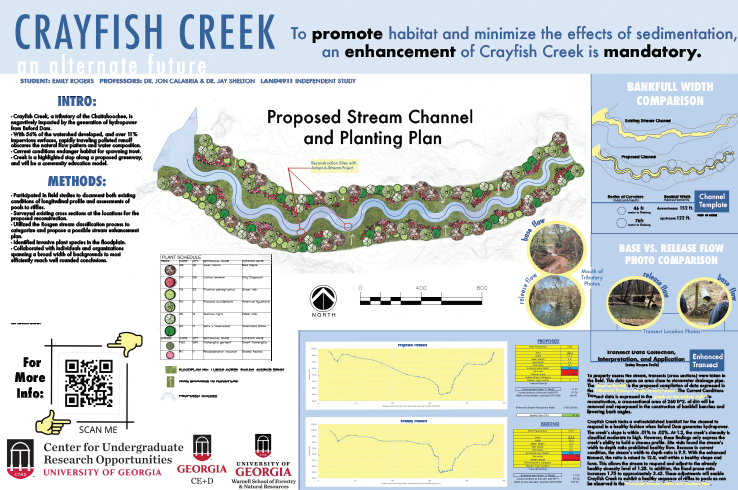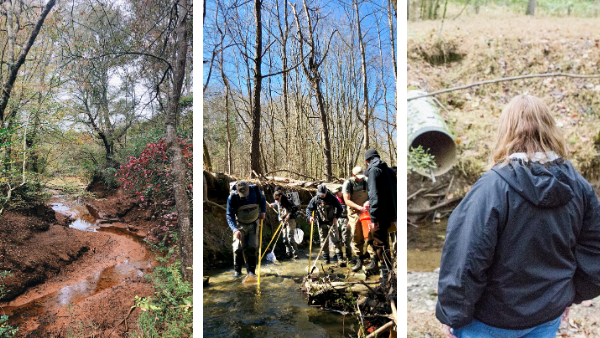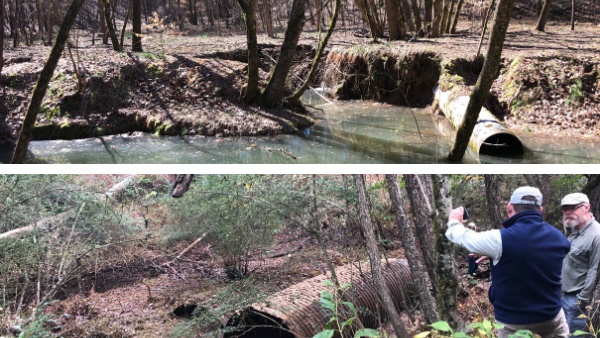CED Undergrad Design Work Leads River Restoration
 Landscape architecture is more than the built environment. As Emily Rogers is learning,
an education in the land arts can also offer a hand to the natural world.
Landscape architecture is more than the built environment. As Emily Rogers is learning,
an education in the land arts can also offer a hand to the natural world.
Rogers, a third-year student in the University of Georgia’s College of Environment and Design, is volunteering her time to assist with a project on a tributary of the Chattahoochee River, Crayfish Creek. Her work aims to restore the eroded creek, located just south of Buford Dam, to improve it for habitat and future recreational use. Crayfish Creek has been selected as one of the featured demonstration sites in the master plan of the Chattahoochee Riverlands Project.
The Chattahoochee Riverlands Project is a proposed initiative to construct Greenways along the major river. Greenways are undeveloped areas set aside for recreation and protection of the environment, like Athens’ Oconee Rivers Greenway. Restoring Crayfish Creek, which plays an incredible role in the health of the Chattahoochee River ecosystem, will not only set the stage for further development of the Greenway, but will allow the ecology of the creek to thrive, including providing a key place for wild trout to spawn. Additionally, the project can attune thousands who live in the greater Atlanta area to the importance of a resilient natural environment.
 Rogers compiled this poster for the UGA's 2020 CURO Symposium. Click here for the full version.
Rogers compiled this poster for the UGA's 2020 CURO Symposium. Click here for the full version.
“Tributaries are, in a way, the keystone species for a resilient river ecosystem. The stream can become the prime location to restore the surrounding environment if enhanced correctly,” says Rogers, who is the Conservation Chair of UGA’s 5Rivers Fly Fishing chapter and a contributing author to 5Rivers Chronicle. 5Rivers is a national network of over 100 college and high school fishing clubs focused on conservation. It is the youth-oriented arm of Trout Unlimited, a national organization dedicated to cold water conservation. Trout Unlimited’s Chattahoochee chapter has been a major stakeholder in the Crayfish Creek restoration project. “This tributary and its enhancement will serve as a blueprint and baseline for the enhancement of countless tributaries across the Southeast, building a system of resilient waterways beneficial to both man and creatures,” Rogers adds.

UGA professors Jon Calabria of the College of Environment and Design and Jay Shelton of the Warnell School of Forestry and Natural Resources are providing guidance throughout the project. Calabria lends design expertise while Shelton provides valuable ecological input.
Their support has been unflinching, lending credence to Calabria’s claim that “[the CED] will take the students as far as they want to go.” Shelton acquired funding for the project via a grant from Trout Unlimited, of which he is a member. Embrace a Stream, a Trout Unlimited program and a stakeholder in the restoration project, focuses on restoring streams across the US.
As the project gained traction, several other organizations took notice and lent their support. Now, several professional, state, regulatory, and environmental groups are involved with this ever-expanding project. Other partners include stakeholders like Chattahoochee Riverkeeper, Chattahoochee National Parks Conservancy, Chattahoochee River Guide Service, and the Georgia Department of Natural Resources, as well as regulatory bodies such as the US Army Corps of Engineers.
Rogers says she is excited for the challenge of improving the waterway but, as Shelton puts it, she has had a “brutal learning curve” to overcome. Even so, he adds that “Students like Emily give us cause for optimism in the field of resource management.”
In addition to flexing her landscape design muscles, Rogers has also been gaining experience in cutting-edge tools and technology that cross the boundary into natural resources and design work.
“We are using many resources that span a broad spectrum of fields,” says Rogers, adding that first the team surveyed and classified the stream characteristics. This data was then used to calculate ideal outcomes for the stream. “If I am being completely honest, I have never done this much math in my life. In terms of software, we use CAD, GIS, LAND, F/X, Stream Stats, Excel and others. I am discovering all of the behind-the-scenes work that goes into proper reconstruction.”

Projects like this one extend beyond the usual parameters of undergraduate work. In addition to gaining class credit via this independent study, Rogers is also receiving practical, on-the-job training and technical skill which will benefit her at the CED and beyond.
Now that her design work is complete, Rogers’ designs will be submitted for a permit and begin the next phase of the process. The US Army Corps of Engineers and other agencies will review the proposal before the project moves to its next stage: turning the designs into reality.
With experience in landscape design, an interest in conservation, and clear career goals, Rogers says she felt like she was in the right place at the right time to help with the project. She is also grateful for the assistance and guidance she has received from Shelton, who advises the 5Rivers club, and Calabria. Their support, she says, has been the most enabling element of the project.
“I desire a project that will educate others on our collective impact and capability to positively impact our backyard ecosystems,” she says. “In terms of personal accomplishments, I hope to learn. I have already learned a lot, but I feel the learning has just begun.”
Rogers’ work is ongoing, so expect updates as they become available.

